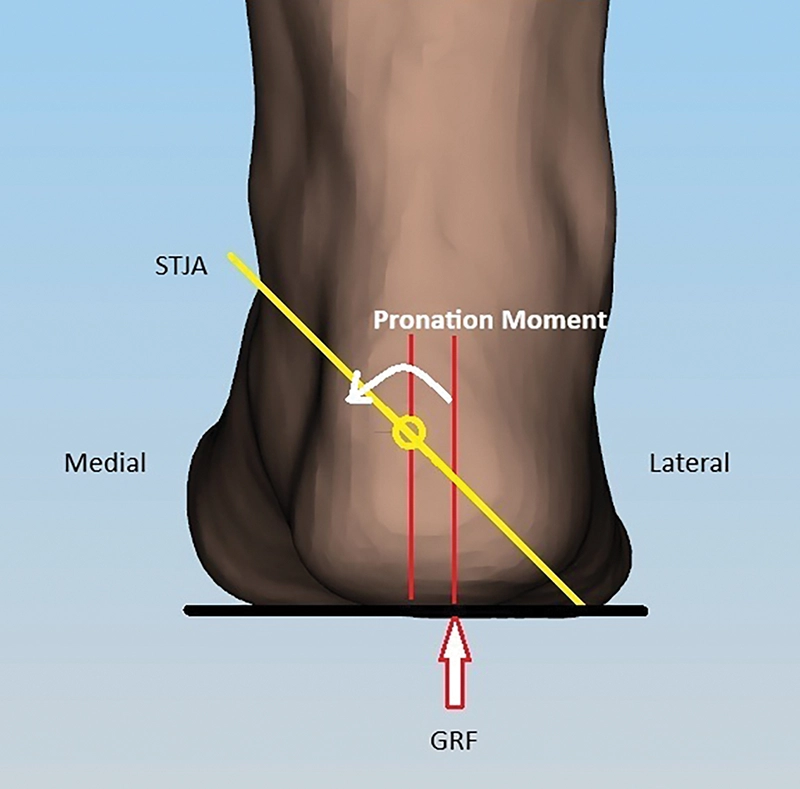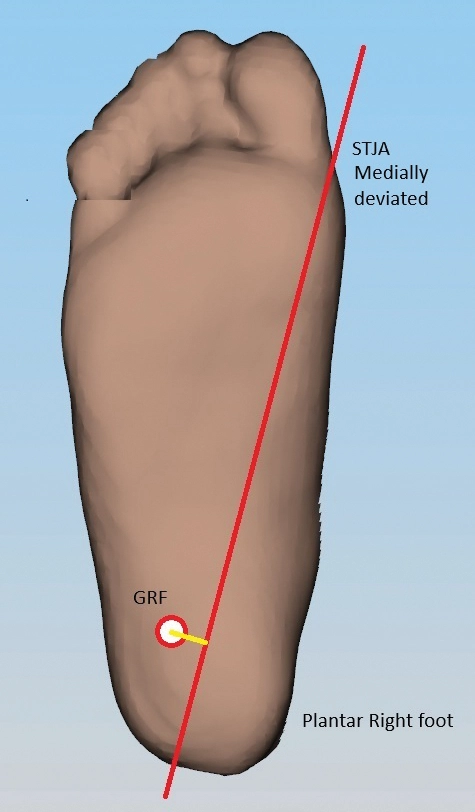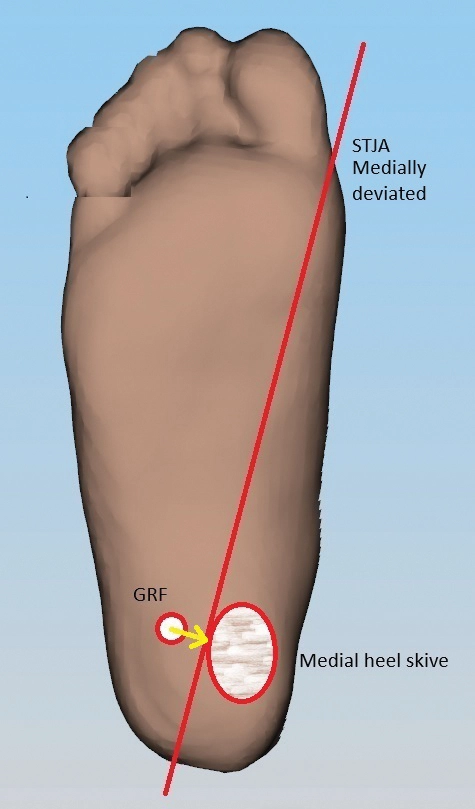Controlling excessive foot pronation is an important aspect of managing many lower-limb pathologies such as plantar fasciitis, posterior tibial tendon dysfunction, pediatric flexible flatfoot, and medial tibial stress syndrome. Supporting the medial longitudinal arch of the foot with orthotics helps position it to improve its function and alleviate symptoms of lower-limb pain.
The medial heel skive technique, also known as the Kirby skive, is a modification that has proven effective for improving pronation control. Developed by Kevin Kirby, DPM, MS, in the early 1990s, this method of cast modification enhances force dynamics at the heel to exert greater influence on subtalar joint motion.1 It is effective in individuals with excessive pronation and especially those with a medially deviated subtalar joint axis (STJA). 
The biomechanical principles underlying the medial heel skive rely on an understanding of the ground reaction force (GRF) acting on the foot and the pronation moment it creates across the STJA. In turn, these help determine the depth and extent of the positive cast correction.
Ground Reaction Force
GRF is the force exerted by the ground on the body in response to its contact with the supporting surface. In gait and stance, this force vector originates at the foot-ground interface and travels upward, interacting with body mass and joint alignment to influence movement.
When the GRF passes lateral to the STJA it creates a pronatory torque on the subtalar joint (Figure 1). Excessive or prolonged pronation moments contribute to conditions including adult acquired flatfoot and medial knee stress. Effective orthotic and pedorthic interventions aim to shift the GRF vector medially, thereby reducing the pronatory torque and supporting more efficient load distribution through the foot and lower limb.
The Subtalar Joint Axis
The subtalar joint (STJ) plays a pivotal role in foot function by allowing motion between the talus and calcaneus. It directly influences the orientation of the midtarsal joint (talonavicular and calcaneocuboid joints), which in turn affects the distal foot. The STJ primarily facilitates foot eversion and inversion (in the frontal plane) but, because of its oblique axis, these movements are coupled with foot abduction/adduction (in the transverse plane) and dorsiflexion/plantarflexion (in the sagittal plane). As a result, the STJ is a complex triplanar joint.
The STJA is typically oriented from posterolateral plantar to anteromedial dorsal, though the degree of angulation varies considerably between individuals. The location of this axis in the transverse plane is crucial in determining the moment arm of GRF acting on the rearfoot. A pronation moment occurs when the GRF passes lateral to the STJA (Figure 2), while a supination moment occurs when it passes medial to it.
The Medial Heel Skive Technique
The medial heel skive was introduced as a modification to custom orthotic and AFO fabrication that increases medial column support without elevating the entire medial heel or adding a bulky extrinsic rearfoot varus post. The main purpose of the medial heel skive is to increase the supination moment by shifting the GRF to pass more medially relative to the STJA. This helps resist excessive rearfoot eversion and supports the medial longitudinal arch during loading response and midstance.
The skive is made in the heel of the orthotic, under the medial aspect of the calcaneus. It starts just anterior to the posterior edge of the orthotic and extends forward to the anterior border of the heel cup. Material is removed from the medial calcaneus in a triangular shape, angled at 15 degrees horizontal. In the days of plaster, this meant filing material off a positive cast, which is now more easily and accurately achieved with digital design software. The result is to flatten the contour of the heel cup on the medial side, pushing the shell up under the heel. This applies an upward force directly beneath the medial calcaneus during weight bearing.
- 2mm skive: Minimal effect, used in mild cases
- 4mm skive: Moderate correction, generally well tolerated
- 6mm skive: Fuller control, for severe pronation or when significant medial heel support is required
Deeper skives increase the magnitude of the GRF but may also reduce comfort and increase the risk of irritation. Importantly, to accommodate the shift in soft tissue that occurs, a mild expansion of the lateral heel of the cast is recommended.
Research supports the ability of the medial heel skive to reduce rearfoot eversion and increase medial plantar pressure. One study using pressure mapping showed that increasing the depth of the medial skive proportionally increased pressure under the medial heel.2 The researchers noted statistically significant increases in pressure compared to a foot orthotic with no medial skive. Although a 2mm skive caused no significant change, a 4mm skive produced a 15 percent increase, and a 6mm skive resulted in a 29 percent increase. Interestingly, these changes did not significantly alter plantar pressures under the midfoot or forefoot.
Biomechanical Effects
The primary mechanical effect of a medial heel skive is the redistribution of GRF beneath the calcaneus. By selectively elevating the medial portion of the heel cup, the skive increases the local plantar pressure under the medial calcaneal tubercle. This shifts the resultant GRF vector medially, decreasing the pronatory torque on the STJA (Figure 4). As a result, the net moment about the STJA is reduced, leading to improved rearfoot alignment and motion control during midstance. It is especially helpful in feet with a medially deviated STJA; in these cases, there is a greatly reduced medial moment arm for the posterior tibial tendon to do its work of resisting pronation.
By increasing the supinatory moment, the medial heel skive counteracts excessive foot eversion and internal rotation of the tibia associated with abnormal pronation. This encourages a more stable foot posture during the load bearing phases of gait. Although the observable results are often subtle, medial skives help improve rearfoot alignment, lessen medial arch collapse during weight bearing, and counteract excessive internal tibial rotation. Altering a patient’s closed chain kinetics in this manner can help alleviate pathology in the foot, ankle, knee, and hip.
Orthotic Design
The medial heel skive is most effective when a patient’s rearfoot exhibits some of the following characteristics:
- A flexible or correctable foot with a calcaneal valgus alignment
- A medially deviated STJA
- Excessive pronation during midstance
- A weak or dysfunctional posterior tibial tendon
By shifting the GRF medially and posteriorly, a medial skive has a better mechanical advantage than a forefoot post. Its effect is to realign the rearfoot without interfering with the forefoot position. Before incorporating a heel skive into a permanent custom device, it can be helpful to test it by adding firm padding, such as a cork oval, into the heel of an existing insole.
The medial heel skive is not a standalone solution, and it is best combined with other orthotic features to improve therapeutic outcomes. Deep heel cups enhance rearfoot control and stabilize the calcaneus. Medial flanges help support the longitudinal arch and are beneficial as long as they do not irritate bony prominences on the midfoot. While a forefoot extrinsic post can support a forefoot varus deformity, it is only effective in reducing the pronatory moment if the post is medial to the STJA.
Despite their benefits, heel skives are not appropriate for all patients. Those with a rigid uncorrectable rearfoot will not respond well to a skive as it can cause excessive pressure and discomfort. Orthotics for patients with heel bursitis or plantar heel pain should not be given a skive as it may only worsen the symptoms. Likewise, those with plantar fat pad atrophy run the risk of heel irritation or bruising. Care must be taken if a patient has lateral ankle instability as a medial skive increases the supination moment and may worsen their instability. Finally, skives can be uncomfortable for some sensitive patients who are not tolerant of firm orthotics. 
Conclusion
The medial heel skive technique is an effective orthotic and AFO modification that enhances pronation control by strategically shifting the ground reaction force under the medial calcaneus. By increasing the supinatory moment across the STJA, it alters a foot’s biomechanics, helping manage excessive pronation and the pathologies associated with it. When used appropriately and with attention to patient-specific biomechanics, a heel skive can yield substantial benefits, especially in those with flexible, correctable flatfoot.
The author gratefully acknowledges the review and approval of Kevin Kirby, DPM, MS, in preparing this article.
Séamus Kennedy, BEng (Mech), CPed, FAAOP(A), is president and co-owner of Hersco Ortho Labs, New York. He can be contacted at seamus@hersco.com or by visiting hersco.com.
References
- Kirby, K. A. 1992. The medial heel skive technique; improving pronation control in foot orthoses. JAPMA 82(4).
- Bonanno, D. R., Z. Zhang, J. Khoury, and H. B. Menz. 2012. The effect of different medial heel skive depths on plantar pressures. Journal of Foot and Ankle Research 5(1):20.





